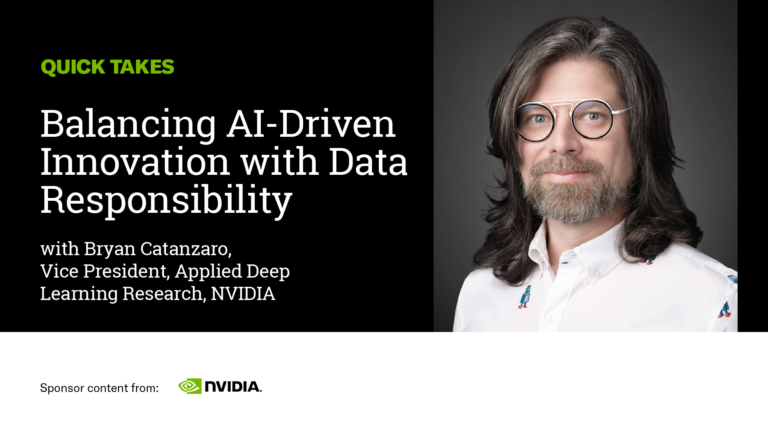Julie Devol, HBR
Welcome to HBR Video Quick Take. I’m Julie Devol, editor of special projects and webinars at Harvard Business Review. Artificial intelligence shows great promise for organizations looking to innovate and disrupt. But many leaders are finding it hard to balance their AI ambitions with their handling of their most precious resource: data.
Today we are joined by Brian Catanzaro, vice president of applied deep learning research at NVIDIA. Brian has been at the forefront of AI development and is here to talk about how AI is driving transformation and data valuation in every organization. Brian, thank you so much for joining us today.
Brian Catanzaro, NVIDIA
I’m happy to be here.
Julie Devol, HBR
Let’s get started. AI has made great strides in enabling new possibilities and innovation. How do you think AI will change the way people connect, communicate, and innovate? And where do you see AI going in the future?
Brian Catanzaro, NVIDIA
Innovation is all about learning – iterating on ideas and striving to understand new ways of thinking about problems. And when we do this, we often get stuck in how it works. I can’t tell you how many times I’ve opened my email client to write an important email only to have no idea where to start.
The great thing about AI is that it enables us to iterate on ideas more quickly and collaboratively, finding better solutions and working at a higher level of abstraction with deeper meaning.
Julie Devol, HBR
We know that data is a valuable resource for businesses today. Brian, what should businesses be thinking about in terms of the value and use of data, especially in areas where AI is seen as disrupting business models?
Brian Catanzaro, NVIDIA
So I believe that every business is built around secrets, and those secrets may be related to the company’s culture, business model, market platform, or technology. And those secrets come with a lot of data that shows how companies do business in proprietary, secretive ways. This means that the most useful data for AI will always be the most secret data.
So there’s a tension between the AI-first way of solving the problem of throwing all your data into one model (which may produce great results in practice, but runs the risk of compromising the secrets that drive your business) and building custom models that are designed to make sense of your company’s small amounts of data and are used in a very targeted way.
I think we need to find policies that allow us to do both well, and I think every company needs to think about how they trade off access to AI with the sensitive data that they have.
Julie Devol, HBR
Business leaders looking to unlock the potential of AI must figure out how to balance driving innovation with responsible data stewardship. How do you think they should approach that challenge, and are there any best practices you can recommend?
Brian Catanzaro, NVIDIA
The first thing I tell companies is to engage in an assessment. When adopting AI, it can be hard to know what success looks like, but the good news is that you can do your assessment independent of the adoption process. You can start doing that right now. Consider what the most important problems your company faces could potentially be solved with AI, and create a success story that shows what AI has to do to help.
AI is becoming easier every day to customize and deploy in any way you need within your enterprise, so get familiar with how AI can potentially help you, so you’re ready to adopt it when the adaptation mechanisms become available.
Julie Devol, HBR
Well, Brian, thank you so much for joining us today and sharing your insights about the role of AI in driving innovation.
Brian Catanzaro, NVIDIA
I’m happy to be here.
Julie Devol, HBR
For more information, click the links below:



